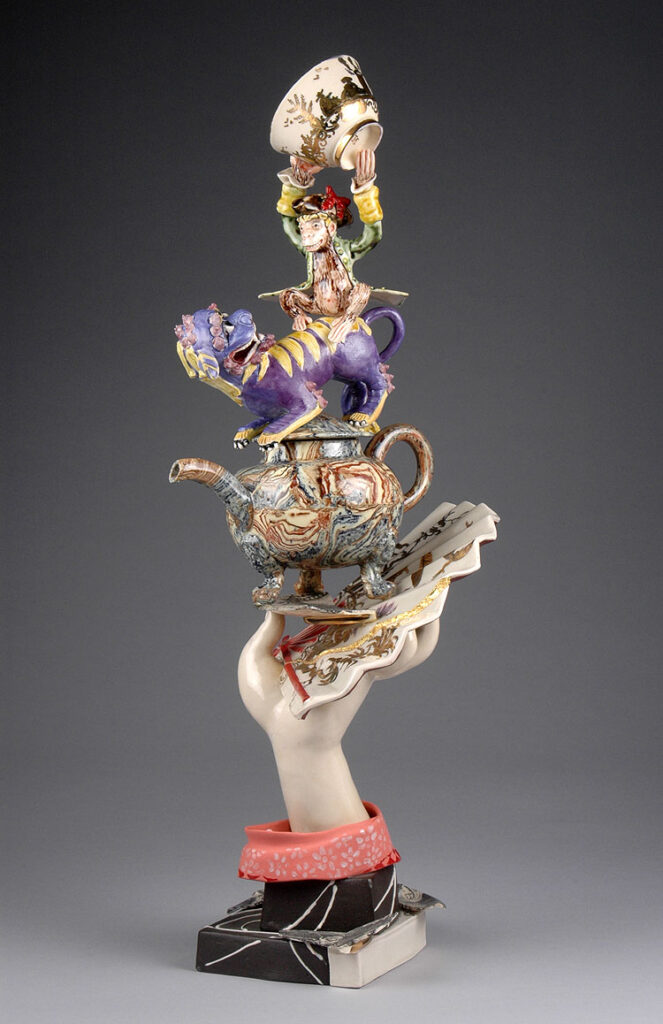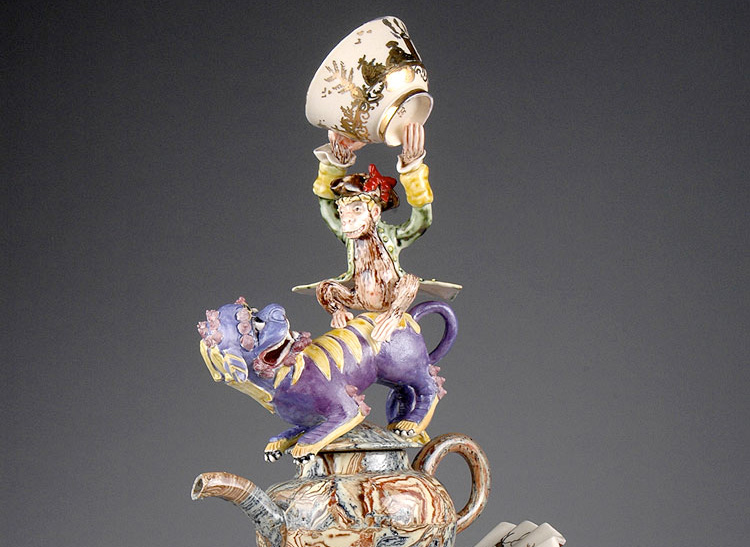“Michelle Erickson is internationally recognized for her mastery of lost ceramic arts during the age of exploration and colonialism. Her contemporary work makes use of these arcane ceramic techniques to create historical narratives about political, social, and environmental issues – past and present. Regardless of time frame, Erickson’s works are distinguished by insightful commentary on the universal character of the human spirit.”[i]
Foundations
Virginia-based ceramicist Michelle Erickson (American, b. 1960) attended the College of William and Mary receiving a Bachelor of Fine Arts in 1982.[ii] She says her “frustration with painting drove [her] to try [her] hand in clay.”[iii] With a “bruised ego,” Erickson signed up for a ceramics class with professor Marlene Jack which she says “felt like…the island of misfit toys.”[iv] However, soon “[she] jumped in with both feet.”[v] Erickson had found a material that spoke to her and “there was no turning back.”[vi]
While at William and Mary, which is located near Colonial Williamsburg, Erickson was exposed to British pottery traditions and began creating reproduction works for Jamestown Pottery. Over time she became “increasingly interested in the ceramics that were found by archaeologists” in this history rich area of the country.”[vii] These discoveries, which ranged from Chinese porcelains to Portuguese delftwares, exposed her to different ceramic styles and techniques beyond the scope of what was covered in a traditional art history class.[viii] Erickson’s curiosity was peaked. She was particularly interested in how these objects were manufactured. This fascination with the “technologies and procedures…used hundreds of years ago” would ultimately impact Erickson’s career from that point onward.[ix]
Inspiration and Concentration
Erickson’s work has been largely influenced by “ceramic history during the period of Western exploration, expansion, and dominion.”[x] British pottery traditions in particular have been a focus. Erickson has created works inspired by seventeenth and eighteenth century earthenware, soft-paste porcelains, and even Josiah Wedgwood’s jasperware.[xi]
While she continues to make reproduction pottery, Erickson’s contemporary designs blend lost “ceramic techniques with modern themes.”[xii] In essence, elements from the past and the present are often brought together in narratives with thought provoking comparisons. For example, in recent years Erickson has drawn parallels between “the eighteenth-century Staffordshire pottery industry and global design giant Nike” as well as “the colonial discovery and obsession with fossils” and “our perilous present-day addiction to fossil fuels.”[xiii]
Through her extensive research Erickson has rediscovered many historical techniques, clay bodies, slips, and glazes. It is important for her “to find the original language of the artifact itself to make a tangible connection to the present.”[xiv] However, she has admitted, “There’s more than one way to skin a cat.[xv]” Erickson understands that the true method of manufacture is probably unrecoverable. With her recreations, the hope is that she achieves a “‘kinetic’ understanding of the way that bygone potters practiced their craft.”[xvi]

Taste in High Life
The Kamm Collection contains the Erickson work Taste in High Life (2004). This glazed porcelain sculpture includes depictions of popular eighteenth-century objects from Eastern and Western cultures. Erickson compiles these objects in a stacked column, an approach she often utilizes. Taste in High Life incorporates items such as a human forearm and hand, a courtesan’s fan, and a recreation of a Staffordshire agate teapot. The teapot’s oversized finial features a purple K’ang-hsi lion.[xvii] A monkey sits on his back holding a white teacup with gilt decoration.
This sculpture references a William Hogarth (1697-1764) etching also called Taste in High Life from the mid-eighteenth century.[xviii] Hogarth, who has been a constant source of inspiration for Erickson, created his version to satirize the clothes and behavior of fashionable society in the early 1740s. The domestic scene contains absurd exaggerations of styles of dress and captures the existing obsession with Chinese motifs. The highlight of Hogarth’s illustration is an elegantly dressed monkey sitting in the foreground. He reads from a French-inspired menu which offers items such as duck’s tongue and rabbit ears. With her depiction, Erickson comments on the role of decorative arts in the twenty-first century. She seems to be questioning how and why art objects can ultimately become commodities dictated by fashion and provenance. By recreating historical symbols of refinement and social status, Erickson connects the past to the present. She irreverently puts this group of desirable forms on an actual pedestal. Each item is stacked and held up high balancing on the palm of a hand. However, this precarious column appears to be destined for disaster. Around the base of the form there are already broken ceramic shards featuring snippets of scenes from Hogarth’s Taste in High Life. Erickson’s sculpture makes you wonder if the art market could suffer the same fate.
At the heart of Erickson’s work, she includes an agate teapot. This form has roots in eighth century China and was produced in England in the eighteenth century. The Kamm Collection has an example of the latter, a Staffordshire teapot (c.1760) with a molded pecten-shell body. It is similar to Erickson’s version in Taste in High Life. Agateware “features swirling marbleized colors” that “imitate the qualities of agate, a semiprecious stone with striated pattern.”[xix] It took Erickson “nearly two years of trial-and-error research” to figure out how to make an agateware teapot.[xx] In 2012, while she was a ceramics resident at the Victoria and Albert Museum in London, Erickson reconstructed an agate teapot from their collection. A corresponding video produced by the museum highlights this complicated process.
Conclusion
Erickson’s work has been widely collected by private collectors as well as public institutions such as the Museum of Arts & Design in Manhattan and the Virginia Museum of Fine Arts in Richmond. This summer the Fuller Craft Museum in Brockton, Massachusetts will feature her ceramics in an exhibition called Another Crossing: Artists Revisit the Mayflower Voyage (July 3 – October 10, 2021). Over the course of her career Erickson has also continued to share her research and scholarship with the decorative arts community. Most notably her discoveries have been highlighted in the annual journal Ceramics in America which is published by the Chipstone Foundation. In the most recent issue Erickson contributed to an interesting article about a rare Dutch black delftware teapot.
Further Reading/Viewing:
Booij, Juriaan. Making an Agate Teapot. Victoria and Albert Museum, 2012.
Booij, Juriaan. Working with London’s Indigenous Clay. Victoria and Albert Museum, 2012.
Lecture- Making History: The Art and Politics of Clay (Michelle Erickson). Bard Graduate Center, 2020.
Notes:

